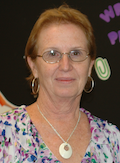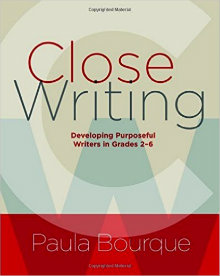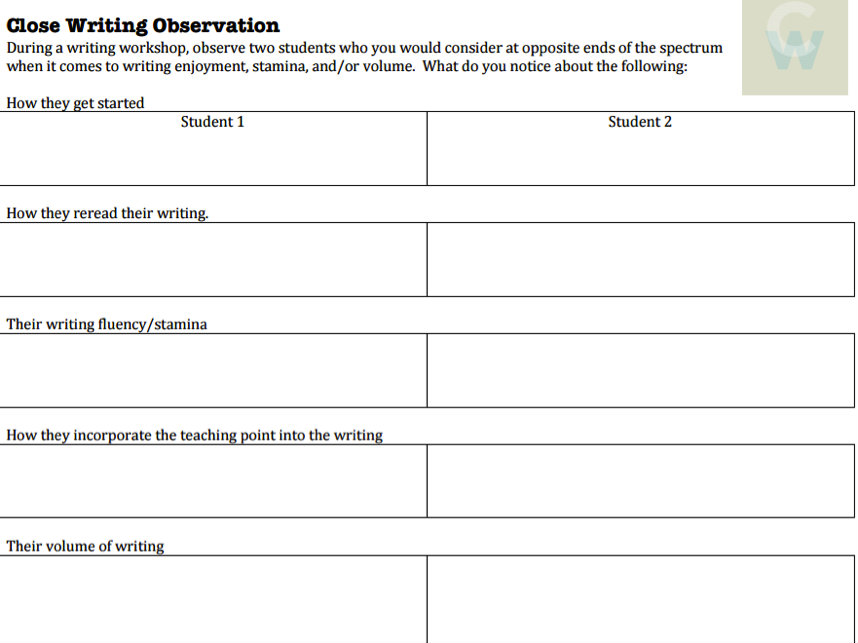Grow Purposeful Writers in the Middle Grades
Close Writing: Developing Purposeful Writers in Grades 2-6
By Paula Bourque
(Stenhouse, 2016 – Learn more)
 Reviewed by Linda Biondi
Reviewed by Linda Biondi
“Read like a detective. Write like a reporter.” —David Coleman
In our classrooms, we all have different types of writers: impetuous writers, frivolous writes, reluctant writers, passionate writers, writers who look like they are writing and produce very little! It makes sense then that there’s not a one-size-fits-all lesson plan to teach writing.
With that understanding in mind, Paula Bourque has written a book that answers some familiar teacher questions: “How can I help my students take ownership of their writing? How can I help them understand that revision and editing is not the end of the writing process? How can I help teach them to be able to closely read their own writing through different lenses? How do I find time for them to do this during Writers or Readers Workshop?”
 As I started to read Close Writing: Developing Purposeful Writers in Grades 2-6, my stomach did flip-flops and I was glad I did not have a heart condition. I was ecstatic! I love close reading. My students are active close readers, but close writers? I was intrigued and, after reading the book, I was inspired and invested in using close writing in my classroom. This definitely is going to be my “go to” book!
As I started to read Close Writing: Developing Purposeful Writers in Grades 2-6, my stomach did flip-flops and I was glad I did not have a heart condition. I was ecstatic! I love close reading. My students are active close readers, but close writers? I was intrigued and, after reading the book, I was inspired and invested in using close writing in my classroom. This definitely is going to be my “go to” book!
Bourque, a literacy coach and classroom teacher of 28 years, writes with a style that encourages the reader to mark, annotate, highlight, and make the book their own. She shares stories from real teachers and students who have invited her into their classrooms to help them “reflect, refine and evolve with their growing experience.” (p. xi)
Tell your own story
Bourque invites her readers to “make revisions to create a story that is relevant to you.” Her invitation made me think. I often highlight and annotate a professional book, but do I really make it my own? I may jot some thoughts or arguments, but I’d never thought of adding my own anecdotes, quotes, and stories to make it a living document. Here was my chance to “co-author.”
The author also gave me a gentle reminder that, “to shift from teaching to learning, it isn’t enough to be satisfied that we teachers are learning to look; the students themselves must learn to look.” (p. 7) Not exactly rocket science, but it is a reminder that since our students are doing the writing, they are the ones who need to monitor their writing. (p. 8) This book is all about helping them learn how to look and grow as independent and responsible writers.
What’s in the book
Close Writing is divided into three parts. The first section, “Guiding Principles,” is a summary of theories that have influenced the author. The second section, “Close Writing Lessons,” is divided into eleven chapters, such as “Close Listening: Developing Our Writer’s Ear,” “Revising, Revisiting, and Revisioning,” and “Eyes and Ears of an Editor.” The final section, “Close Writing with Authors,” includes interviews with authors about their own writing stories.
Each chapter begins with discoveries about close writers and glimpses into classrooms (Moral of This Story); each shares strategies applicable for ELL students (Considerations for English Language Learners); and each ends with a brief summary of the key ideas (The Gist of the Story) and the invitation to reflect and plan (Drafting Your Story).
Teachers of writing practice what they preach
One thought resounded in my mind as I read the book, and that was to remember that as a teacher of writing, I need to continue to write more often, to develop my craft, and to start “practicing what I preach.” I ask my students to find time to write and to study mentor authors, but do I take the time to study my own mentor authors?
Several years ago, I co-facilitated a “Teachers as Writers, Writers as Teachers” group in my school district. As a result of being a part of that group, I became a better writer and teacher of writing. I wrote with my colleagues, shared my writing with my colleagues, and studied my colleagues’ writing. They were my mentors.
The chapter, “Close Modeling: Learning from Mentor Authors,” reminded me of this special time that I treasure to this day. This chapter is indicative of all the chapters in the book. It contains practical, easy-to-implement and innovative ideas that will enhance your Writers Workshop experience without taking time away from what our students need to do — write.
As I continued to read, I gained so many ideas: becoming writing buddies and having fourth grade students co-write with first graders; having virtual writing buddies and videotaping or face-timing with writers; sponsoring a writing club for my students; starting up a teacher’s writing group again, and sharing my writing journey with my students.
Generous resources
I couldn’t believe how generous Bourque was with her help. Additional resources, photos and templates for each section are found online at www.stenhouse.com/closewritingbook, including interviews with a variety of writing experts.
Bourque also provides the reader with actual charts that she uses in the book, chapter by chapter. As if that’s not generous enough, she also has links to videos of teachers engaged in the use of close writing in their own classrooms, plus study guides for professional book club meetings.
This book is meant to be read and reread. To be read closely…To be read with a colleague…to be read at the beach…to be read here, there and everywhere!
Linda Biondi is a fourth grade teacher at Sharon Elementary School in Robbinsville, NJ, a frequent MiddleWeb reviewer, and a long-time Morning Meeting practitioner. She’s also the recipient of several educational grants, a Teacher Consultant with the National Writing Project and a participant on the NJ Department of Education Teacher Advisory Panel. Linda participates in ECET2 Celebrate Teaching which has posted an interview with her.



































